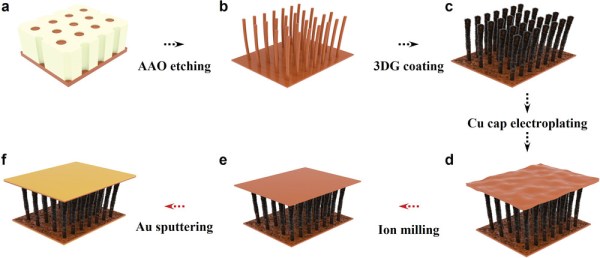With the increasing waste heat production by today’s electronics in ever smaller spaces, drawing this heat away quickly enough to prevent thermal throttling or damage is a major concern. This is where research by Lin Jing and colleagues from Carnegie Mellon University’s Department of Mechanical Engineering demonstrates a thermal interface material (TIM) that should provide a significant boost here. In the article, published in ACS Nano (paywalled; open access preprint alternative) the construction of this copper and graphene ‘sandwich’ TIM is described, along with tests.
The general idea is to use pillars between the two surfaces that can quickly carry the heat from the hot surface to the cool one. Although pure copper versions exist and do work, they suffer from the complications of having to build up these copper pillars in place, and subsequent oxidation reducing the effectiveness. While graphene and similar materials have shown superior heat-transfer capabilities, interfacing these materials with copper and other metals has proven problematic.
What Lin Jing et al. demonstrate in this study is to use essentially the pure copper approach, but to combine it with earlier research by Raghav Garg et al. (2017), who demonstrated how to grow 3-dimensional graphene structures. By cladding the copper pillars with graphene, this material improves heat transfer by 60%, while preventing oxidation of the metal. While the challenge is obviously to transfer these findings to something that can be mass-produced for consumer devices, it demonstrates how much potential there is in the use of graphene, which is a relatively new material for such applications due to how hard it was to produce until recently.












